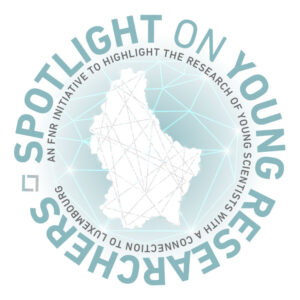BACK TO RESEARCH WITH IMPACT: FNR HIGHLIGHTS
BACK TO RESEARCH WITH IMPACT: FNR HIGHLIGHTS
Neurodegenerative diseases and cancer affect millions of people worldwide, especially people over 60. While advances in diagnosis and treatment have been made, there are still many open questions on the path to better treatment and earlier diagnosis. Translational neuroscientist Pauline Mencke studies a gene that is involved both in Parkinson’s disease and the brain cancer Glioblastoma multiforme.
Parkinson’s disease (PD) is the second most common neurodegenerative disease affecting 1-2% of the world’s population over the age of 60. The disease mainly manifests as impaired movement, caused by the loss of specific nerve cells in the brain that are responsible for controlling movement initiation.
Over the years, scientists have identified many genes that are causative for monogenic forms of PD, but efforts continue to find ways to improve treatment and diagnosis: So far, there is no cure for PD and no treatment that will stop the progress of the disease, which is why current treatment strategies are only symptomatic.
Glioblastoma multiforme (GBM) is the most malignant brain tumour, responsible for around 2.5% of cancer deaths worldwide. The age range of GBM patients is quite wide, ranging from approximately 45-75 years. GBM is characterized by poor prognosis, low survival rates, and extremely limited opportunities for therapy. Current standard therapy is a combination of maximal safe surgical resection of the tumour and subsequent radiation and chemotherapy. However, even with advances in surgical resection, the prognosis for GBM patients remains very poor: Around 75% of GBM patients die within 12 months of their diagnosis – only around 5% survive for five years or longer.
Understanding the gene PARK7 encoding the protein DJ-1 to find common disease mechanisms
What do Parkinson’s disease and Glioblastoma multiforme have in common?
“Due to the complexity and heterogeneity of PD, the etiology is not yet fully understood. This is why there is no cure for the disease”, explains biologist Pauline Mencke.
“In the same manner, GBM is a very heterogeneous and complex disease, meaning that it is very difficult to identify individual causes and treatment strategies that are tumour specific.”
In the last years, there has been increasing evidence that a specific gene encoding the protein DJ-1 is associated with both diseases. As part of her PhD project, biologist Pauline Mencke is studying the role of DJ-1 in more detail:
“We know that genes that are upregulated in cancer are frequently downregulated in PD and vice versa.”, Pauline explains.
“Interestingly, increased expression of some PD-associated genes like one called ‘PARK7 (DJ-1)’ influence cell proliferation and metabolism, meaning they support tumorigenesis – the formation of tumours.”
“In PD, the effect reverses, as loss of DJ-1 protein function causes PD. In the scope of my PhD project, we are simultaneously studying the role and function of DJ-1 in PD and GBM to better understand its role in both conditions.”
A collaborative effort
Pauline collaborates with several scientists for her project, both in Luxembourg and abroad:
“The PD-patient derived iPSCs [stem cells] that I am using for my project were obtained from fibroblasts from a collaboration with Prof. Dr. med. Vincenzo Bonifati from Rotterdam.
“For the CRISPR Cas9 mediated correction of the mutation in the iPSCs, I profited from the expertise of Dr. Javier Jarazo from the LCSB. I am also collaborating with ATTRACT Fellow Dr. Johannes Meiser from the LIH, who is helping me through his expertise in metabolomics.
“Finally, in collaboration with Dr. Carole Linster from the LCSB, we are trying to identify enzymatic functions of DJ-1, while Prof. Dr. med. Michael Platten from the DKFZ in Heidelberg is advising me with his excellent experience in Glioblastoma research.”
The aim of the research is to identify common mechanisms shared by the diseases – this would allow for the identification of a common pathway and potential drug target, ultimately improving the outlook for patients.
Pauline Mencke, 3rd year PhD candidate at the Luxembourg Centre for Systems Biomedicine (LCSB). Her PhD is supported by an AFR grant from the FNR.
MORE ABOUT PAULINE MENCKE
On progress already made during her current project
“I corrected the DJ-1 mutation in PD-patient-derived cells to generate isogenic controls. Using these models, I found that DJ-1 deficiency affects astrocytes more than neurons regarding their metabolism. Knockdown of DJ-1 in GBM cells has a similar effect as in astrocytes, suggesting a common mechanism in PD and GBM.”
On choosing Luxembourg as a research destination
“I have studied molecular medicine in Regensburg (Germany) and from the beginning of my studies, I was interested in translational medicine, studying causes and mechanisms of diseases to help to identify better treatments. During my master studies in Luxembourg, I met Prof. Dr. med. Rejko Krüger and learned about his excellent research. This is why I decided to do my PhD in his highly interdisciplinary translational group.”
More about Pauline Mencke’s research:
Mencke P, Hanss Z, Boussaad I, Sugier PE, Elbaz A, Krüger R. Bidirectional Relation Between Parkinson’s Disease and Glioblastoma Multiforme. Front Neurol. 2020 Aug 20;11:898. doi: 10.3389/fneur.2020.00898. PMID: 32973662; PMCID: PMC7468383.
Mencke P, Boussaad I, Romano CD, Kitami T, Linster CL, Krüger R. The Role of DJ-1 in Cellular Metabolism and Pathophysiological Implications for Parkinson’s Disease. Cells. 2021 Feb 7;10(2):347. doi: 10.3390/cells10020347. PMID: 33562311; PMCID: PMC7915027.
About Spotlight on Young Researchers
Spotlight on Young Researchers is an FNR initiative to highlight early career researchers across the world who have a connection to Luxembourg, with nearly 100 features published since 2016.





